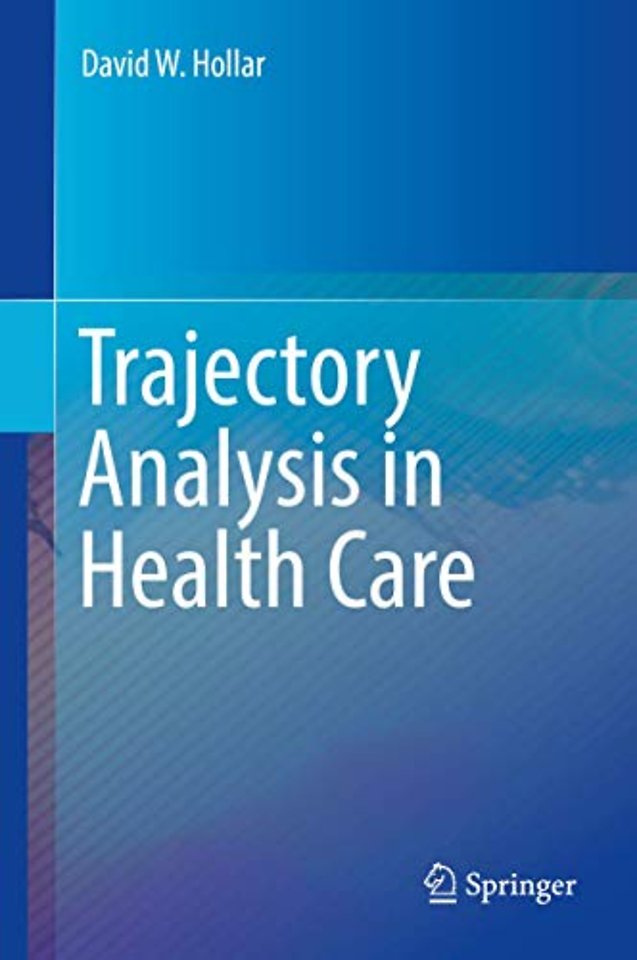



David Hollar, PhD Education, MS Molecular Biology, Postdoc Community Health Disability and Employment, Associate Professor of Health Administration at Pfeiffer University, North Carolina (Current) and of Children with Genetic/Metabolic Conditions at the University of Tennessee (Past).
Meer over David HollarTrajectory Analysis in Health Care
Samenvatting
This innovative volume introduces Trajectory Analysis, a new systems-based approach to measuring nonlinear dynamics in continuous change, to public health and epidemiology. It synthesizes influential strands of statistical and probability science (including chaos theory and catastrophe theory) to complement existing methods and models used in the health fields.
The computational framework featured here pinpoints complex cause-and-effect processes in behavioral change as individuals and populations adjust to health interventions, with examples from neuroscience and cardiology. But this is no mere academic exercise, as the author illustrates how these methods can be harnessed toward finding real-world answers to longstanding public health problems, starting with treatment recidivism.
Included in the coverage:
-The universality of physical principles in the analysis of health and disease
-The problem of recidivism in healthcare intervention studies
-Stability and reversibility/irreversibility of health conditions
-Chaos theory and sensitive dependence on initial conditions
-Applications in health monitoring and geographic systems
-Simulations, applications, and the challenge for public health
A stimulating new take on statistics with powerful implications for future study, practice, and policy, Trajectory Analysis in Health Care should interest public health epidemiologists, researchers, clinicians, and policymakers.
Trefwoorden
Specificaties
Inhoudsopgave
References 5
2 Longitudinal and Nonlinear Dynamics “Trajectory” Analysis in Health Care: Opportunities and Necessity 7
2.1 Background 8
2.2 Necessary and Sufficient Conditions 10
2.3 Decision-Making in Longitudinal Research 12
2.4 Nonlinear Dynamics 14
References 18
3 The Problem of Recidivism in Healthcare Intervention Studies 21
3.1 Periodic Behavior 22
3.2 Stages of Change Models 24
3.3 Education, Race, Socioeconomics 26
3.4 Biopsychosocial Models 27
3.5 Health Literacy Issues in Recidivism 29
3.6 Examples 29
3.7 Behaviors Locked in Periodic Patterns 30
3.8 Tinbergen’s Four Questions and Ethology 31
3.9 The Issue of Creating Bifurcations 32
References 34
4 Epidemiological Methods 37
4.1 Types of Studies 38
4.2 Non-experimental Studies 42
4.3 Demographic Considerations 44
4.4 Methods of Analysis 45
4.5 Summary 46
References 46
5 The Method of Path Coefficients 49
5.1 Background 49
5.2 Path Coefficients 51
5.3 Structural Equation Models 54
5.4 Hierarchical Linear Models 59
5.5 Examples 62
5.6 Agent-Based Models 63
5.7 Nonlinearity . 64
5.8 Causal Inference and Complexity 66
5.9 Validity and Reliability (Accuracy and Precision) 67
5.10 Summary 69
References 70
6 Stability and Reversibility/Irreversibility of Health Conditions 73
6.1 Irreversible Change and the Arrow of Time 74
6.2 Levels of Functioning 76
6.3 Measuring Disturbances to Functioning 77
6.4 Human Development 79
6.5 Summary 83
References 84
7 Energy Levels and Potentials 87
7.1 Energy Is Central to Life Processes, Health, and Change 87
7.2 Quantum Metabolism and Health 88
7.3 Systems Topology and Ecology 90
7.4 Catastrophes 91
7.5 Energetic Jumps and Interventions 93
7.6 Stability and Instability in Health 96
7.7 Summary 98
References 98
8 On Negative Probabilities and Path Integrals 101
8.1 Healthcare Analysis and Medical Errors 101
8.2 Population Health Distributions 102
8.3 Superposition of Wave Phases (States) and Negative Probability 104
8.4 Applications of Negative Probabilities 106
8.5 Cancer 108
8.6 Balancing Health and Probabilities 109
8.7 The Wave Function 109
8.8 Feynman’s Path Integrals and Wright’s Path Coefficients 112
8.9 Coupling, Accounting, and Superposition 113
8.10 Conclusion: Nonaction as Action in Paths 114
References 114
9 Chaos Theory and Sensitive Dependence on Initial Conditions 117
9.1 Sensitive Dependence on Initial Conditions 118
9.2 The Lorenz Attractor and Chaos 118
9.3 Phase Space 121
9.4 The Systems Perspective 122
9.5 Ecological Systems and Health 123
9.6 Complexity and Stability 127
9.7 Summary 129
References 129
10 Poincare Return Maps 131
10.1 Periodicity and Trajectories 131
10.2 The Return Map . 133
10.3 Superposition of Harmonics 136
10.4 Phases and Periodicity 139
10.5 Physiological Periodicity 142
10.6 Summary 144
References 144
11 Health Conditions and Behaviors as Surfaces 147
11.1 Topology, Surfaces, and Manifolds 148
11.2 Driving and Dissipative Forces on Trajectories 152
11.3 Examples 154
11.4 Phase Space Resetting and Health 156
11.5 Summary 160
References 161
12 Jacobian Matrices and Lyapunov Exponents 163
12.1 The Jacobian Matrix 164
12.2 Transition Points 166
12.3 Examples 168
12.4 An Applied Health Research Example 171
12.5 Summary 176
References 177
13 Jump Conditions 179
13.1 Rapid Change 179
13.2 Thresholds 180
13.3 Phase Transitions at the Biological Systems Level 181
13.4 The Phase Transition 183
13.5 The Rankine-Hugoniot Jump
13.6 Critical Opalescence 190
13.7 Jumps in Health Trajectories 191
References 192
14 Applications to Cardiology and Neuroscience 197
14.1 History of Nonlinear Dynamics in Physiology 198
14.2 Phase Resetting 200
14.3 Neuroscience Models 202
14.4 Hydrodynamics 205
References 207
15 Understanding the Evolutionary Historical Background Behind the Trajectories in Human Health and Disease . . . . . . . . . . 211
15.1 The Relevance of Hierarchy 212
15.2 Health, Systems, and the Development of Life on Earth 214
15.3 The Major Histocompatibility Complex (MHC), Immunity, and Behavior 217
15.4 The Brain–Body Connection 221
15.5 Stress and Behavior in Health Trajectories 222
15.6 Olfactory Pathways and the MHC 224
15.7 Summary 226
References 226
16 Simulations, Applications, and the Challenge for Public Health 231
16.1 Simulations 232
16.2 An Example: Wilensky’s Sheep–Wolf Predation 233
16.3 Running the Model 235
16.4 Simulations in Trajectory Change 243
16.5 Implications for Health Trajectory Analysis 244
16.6 Summary 245
References 245
17 Review of Basic Principles 247
17.1 Principles 248
17.2 Methods 249
17.3 The Future 250
17.4 Context 252
17.5 Perspective 255
17.6 Summary 255
References 256
Index
Vaak samen gekocht
Anderen die dit boek kochten, kochten ook
Rubrieken
- cadeauboeken
- computer en informatica
- economie
- filosofie
- flora en fauna
- geneeskunde
- geschiedenis
- gezondheid
- jeugd
- juridisch
- koken en eten
- kunst en cultuur
- literatuur en romans
- mens en maatschappij
- naslagwerken
- non-fictie informatief/professioneel
- paramedisch
- psychologie
- reizen
- religie
- schoolboeken
- spiritualiteit
- sport, hobby, lifestyle
- thrillers en spanning
- wetenschap en techniek
- woordenboeken en taal







